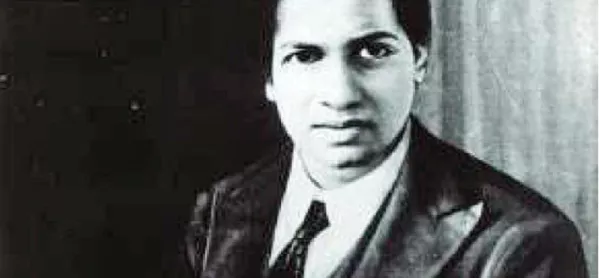Maths has hit the big screen again, with the UK release of The Man Who Knew Infinity. The film adaptation of Robert Kanigel’s biography of the same name chronicles one of the most celebrated stories in all mathematics.
A century ago, Srinivasa Ramanujan (pictured) and GH Hardy, two men from opposite worlds, forged an unlikely partnership to advance mathematics research. Their story is a triumph of cross-cultural collaboration that carries profound lessons for maths educators.
Ramanujan was born and raised in rural India. He was a mathematical genius in the true sense of the word. From a young age, he mystified teachers and peers alike with his command of complex formulas. But Ramanujan toiled in an education system that only rewarded conformity. That all changed when he stumbled upon a primitive and outdated maths textbook (today’s equivalent of an O-level textbook, perhaps). From this single text, Ramanujan derived deep mathematical theorems, many of them unknown to even the best minds of his time.
Clash of cultures
Ramanujan sent his manuscripts to leading mathematicians in England. Most of them dismissed Ramanujan as a crank, except for one: Hardy. A maths fellow at Trinity College, Cambridge, Hardy saw the genius within Ramanujan and arranged for him to visit Cambridge. There the two men enjoyed a fruitful collaboration in the years leading up to the First World War, breaking new ground in the field of number theory (the film’s title is inspired by Ramanujan’s expertise with infinite structures such as continued fractions).
This is not a rags-to-riches story. Ramanujan struggled to adapt to life in England: the clash of cultures even drove him to a suicide attempt. But by the time he returned to India, Ramanjuan’s legacy as a mathematician was cemented - his ideas continue to impact on scientific research a century later. And the Hardy-Ramanujan collaboration, though brief, left behind an important lesson for those of us working to advance the learning and teaching of maths.
Confounding stereotypes
People tend to think of mathematicians as all being alike. It’s not a flattering stereotype and, as a former mathematician myself, I’ll spare my brethren a formal description.
Yet Hardy and Ramanujan were quite the odd couple. They were diametrically opposed in their approaches to problem-solving. Hardy was trained with all the formality that comes with a Cambridge maths degree. He was an atheist evangelist and, for him, logical reasoning and rigorous proof were king. Ramanujan, on the other hand, was from the Hindu Brahmin tradition, and relied on a holistic approach grounded in intuition and regular leaps of faith.
This often proved a challenge for these two mathematical giants. Dev Patel, who plays Ramanujan, describes the collaboration as a dysfunctional father-son relationship. Hardy was not fully aware of Ramanjuan’s background, but was sensitive to his protégé’s modes of thinking. Hardy made a conscious effort not to force formal instruction on Ramanujan, realising that this would only stifle the young genius.
This compromise worked wonders: the two men ultimately bridged their intellectual divide and uplifted one another with their complementary styles. Hardy would later describe their collaboration as the most romantic affair of his life. High praise indeed.
1+1=?
What Hardy and Ramanujan had in common is that their beliefs and experiences shaped their way of thinking and being. Their story is profoundly important because it reminds us that maths is innately cultural.
Mathematics may be a discipline of universal truth, but we engage with that truth according to our cultural sensibilities. The way in which we interact with mathematical concepts is entwined with our beliefs and experiences. For example, we all accept (I hope) that 1+1=2, but our reasons for studying number can vary greatly. The fruit seller in Brazil who relies on mental agility may have different motives from the Greek philosopher searching for deeper meaning in things. Both can employ maths to connect to the world around them, but each perceives that world through a distinctive lens.
This is why cherry-picking practices from faraway education systems is folly. Context matters: assuming that every student is subject to the same world view is misguided. The onus is on educators to situate maths within the sociocultural context of each student.
Educators exist to extend learning opportunities to every child, but we will fail our students if we strip them of their individuality. The way in which we design lessons or present a problem must take account of learners’ dispositions.
The story of Hardy and Ramanujan embodies the essence of that buzzword, “personalisation”: a complex and multifaceted goal, but one that deserves all the cultural nuance we can give it.
Junaid Mubeen is a research mathematician turned educator, working at the nexus of education, innovation and technology. He blogs here, and tweets as @fjmubeen
Want to keep up with the latest education news and opinion? Follow TES on Twitter and like TES on Facebook




